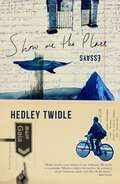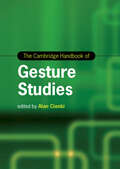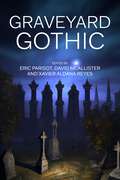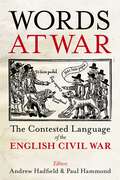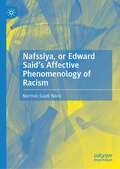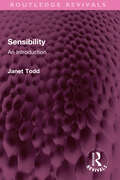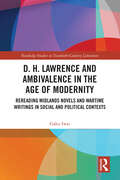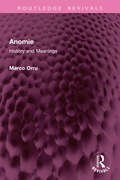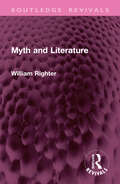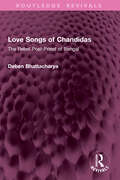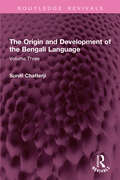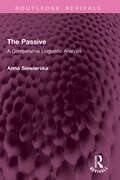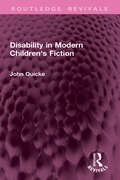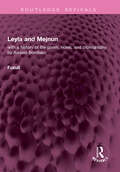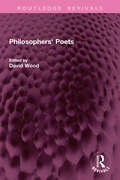- Table View
- List View
Show Me The Place: Essays
by Hedley TwidleApocalyptic futures surround us. In films, books and in news feeds, we are subjected to a barrage of end-time possibilities. Award-winning writer Hedley Twidle, in quixotic mood, sets out to snatch utopia from the jaws of dystopia. Whether embarking on a bizarre quest to find Cecil Rhodes's missing nose (sliced off the bust of the Rhodes Memorial) or cycling the Scottish islands with a couple of squabbling anarchists; whether learning to surf (much too late) in the wild, freezing waters off the Cape Peninsula or navigating the fraught polities of a Buddhist retreat centre, the author explores forgotten utopias, intentional communities and islands of imagination with curiosity, hope and humour. Ranging from the science fiction of Ursula Le Guin to the 'living laboratory' of Auroville in south India, Show Me the Place investigates the deep human desire to imagine alternatives to what we take as normal or inevitable.
The Cambridge Handbook of Gesture Studies (Cambridge Handbooks in Language and Linguistics)
by Alan CienkiThe study of gesture-the movements people make with their hands when talking-has grown into a well-established field and research is still being pushed into exciting new directions. Bringing together a team of leading scholars, this Handbook provides a comprehensive overview of gesture studies, combining historical overviews as well as current, concise snapshots of state-of-the-art, multidisciplinary research. Organised into five thematic parts, it considers the roles of both psychological and interactional processes in gesture use, and considers the status of gesture in relation to language. Attention is given to different theoretical and methodological frameworks for studying gesture, including semiotic, linguistic, cognitive, developmental, and phenomenological theories and observational, experimental, corpus linguistic, ethnographic, and computational methods. It also contains practical guidelines for gesture analysis along with surveys of empirical research. Wide ranging yet accessible, it is essential reading for academic researchers and students in linguistics and cognitive sciences.
Graveyard Gothic
by Eric Parisot, David McAllister and Xavier Aldana ReyesGraveyard Gothic is the first sustained consideration of the graveyard as a key Gothic locale. This volume examines various iterations of the Gothic graveyard (and other burial sites) from the eighteenth century to the twenty-first, as expressed in numerous forms of culture and media including poetry, fiction, TV, film and video games. The volume also extends its geographic scope beyond British traditions to accommodate multiple cultural perspectives, including those from the US, Mexico, Japan, Australia, India and Eastern Europe. The seventeen chapters from key international Gothic scholars engage a range of theoretical frameworks, including the historical, material, colonial, political and religious. With a critical introduction offering a platform for further scholarship and a coda mapping potential future critical and cultural developments, Graveyard Gothic is a landmark volume defining a new area of Gothic studies.
Graveyard Gothic
by Eric Parisot David McAllister Xavier Aldana ReyesGraveyard Gothic is the first sustained consideration of the graveyard as a key Gothic locale. This volume examines various iterations of the Gothic graveyard (and other burial sites) from the eighteenth century to the twenty-first, as expressed in numerous forms of culture and media including poetry, fiction, TV, film and video games. The volume also extends its geographic scope beyond British traditions to accommodate multiple cultural perspectives, including those from the US, Mexico, Japan, Australia, India and Eastern Europe. The seventeen chapters from key international Gothic scholars engage a range of theoretical frameworks, including the historical, material, colonial, political and religious. With a critical introduction offering a platform for further scholarship and a coda mapping potential future critical and cultural developments, Graveyard Gothic is a landmark volume defining a new area of Gothic studies.
Words at War: The Contested Language of the English Civil War (Proceedings of the British Academy #261)
by ANDREW HADFIELD AND PAUL HAMMONDThe English Civil War was not simply a conflict between two opposing, unstable, complicated alliances of various factions, but a war of words. Supporters of the King and allies of Parliament and the New Model Army clashed over ideals, ideas, and concepts as they each sought to impose their understanding of history and visions of the future, realizing that victory could only be secured by establishing a political and cultural language that would guide and direct those who used it. Accordingly, the Civil War witnessed vociferous arguments over many key English words central to life and thought in the seventeenth century, and often up to the present day. Words at War seeks to bring together scholars of literature, history, religion, and philosophy to analyse the ways in which key terms were deployed and debated in the Civil War and Commonwealth. In doing so it refocuses attention on ideas and concepts that shaped the modern world well beyond the bloody conflict on the battlefield.
Nafssiya, or Edward Said's Affective Phenomenology of Racism
by Norman Saadi NikroThis book adapts the Arabic term nafsiyya to trace the phenomenological contours of Edward Said’s analysis of the affective dimensions of colonial and imperial racism. Reflecting on what he called his “colonial education,” Said rendered his Palestinian/Arab background and experience of racism an enabling component of his academic work. The argument focuses on his “personal dimension” section in his introduction to his famous volume Orientalism, discussing key notions of Said’s oeuvre—such as ‘elaboration,’ ‘circumstance,’ ‘humanism,’ ‘worldliness,’ ‘inventory,’ and ‘critical consciousness.’ Providing a lengthy study of his earlier and somewhat neglected Beginnings: Intention and Method, the book discusses the significance of the style of the essay as a key component of what the author calls Said’s interventionist brand of scholarship. The final chapter outlines how Said’s oeuvre can be situated in a genealogy of a radical phenomenology of racism that emerged from the colonies.
Sensibility: An Introduction (Routledge Revivals)
by Janet ToddThe cult of sensibility jangled the nerves of Europe in the mid-eighteenth century. It touched all literary genres and brought into prominence those qualities of tenderness, compassion, sympathy and irrational benevolence associated with women by the binary psychology of the time. It privileged spontaneous emotion and found this expressed in the bodily manifestations of tears, fainting fits, flushes and palpitations. Valuing the pure victim, it took as its archetypes the innocent dying Clarissa and the benevolent, suffering man of feeling.In Sensibility, originally published in 1986, Janet Todd charts the growth and decline of sentimental writing as a privileged mode in the eighteenth century. She shows how sentimental writing is riven with contradictions: while it applauds fellowship, it also expresses a yearning for isolation, and while it stresses the ties of friendship and family, it does so at the expense of sexual feeling, which grows menacing and destructive.By the 1770s, as the idea of sensibility was losing ground, ‘sentimentality’ came in as a pejorative term. Janet Todd ends her study of sensibility by detailing the various attacks on the cult, from radicals and conservatives, feminists and Christian moralists; from Coleridge who saw it as unmanning the nation to Jane Austen who considered it an elaborate sham
Sensibility: An Introduction (Routledge Revivals)
by Janet ToddThe cult of sensibility jangled the nerves of Europe in the mid-eighteenth century. It touched all literary genres and brought into prominence those qualities of tenderness, compassion, sympathy and irrational benevolence associated with women by the binary psychology of the time. It privileged spontaneous emotion and found this expressed in the bodily manifestations of tears, fainting fits, flushes and palpitations. Valuing the pure victim, it took as its archetypes the innocent dying Clarissa and the benevolent, suffering man of feeling.In Sensibility, originally published in 1986, Janet Todd charts the growth and decline of sentimental writing as a privileged mode in the eighteenth century. She shows how sentimental writing is riven with contradictions: while it applauds fellowship, it also expresses a yearning for isolation, and while it stresses the ties of friendship and family, it does so at the expense of sexual feeling, which grows menacing and destructive.By the 1770s, as the idea of sensibility was losing ground, ‘sentimentality’ came in as a pejorative term. Janet Todd ends her study of sensibility by detailing the various attacks on the cult, from radicals and conservatives, feminists and Christian moralists; from Coleridge who saw it as unmanning the nation to Jane Austen who considered it an elaborate sham
D. H. Lawrence and Ambivalence in the Age of Modernity: Rereading Midlands Novels and Wartime Writings in Social and Political Contexts (Routledge Studies in Twentieth-Century Literature)
by Gaku IwaiD. H. Lawrence is renowned for his scathing criticism of the ruling class, industrialisation of the country and wartime patriotism. However, his texts bear the imprint of contemporary dominant ideologies and discourses of the period. Comparing Lawrence’s texts to various major and minor contemporary novels, journal articles, political pamphlets and history books, this book aims to demonstrate that Lawrence’s texts are ambivalent: his texts harbour the dynamism of conflicting power struggles between the subversive and the reactionary. For example, in some apparently apolitical texts such as The White Peacock and Movements in European History, reactionary ideologies and wartime propaganda are embedded. Some texts like Lady Chatterley’s Lover are intended to be a radical critique of the period wherein it was composed, but they also bear discernible traces of the contemporary frame of reference that they intend to subvert. Focusing on Lawrence’s stories and novels set in the mining countryside and the works composed under the impact of the First World War, this book establishes that Lawrence’s texts in fact consist of multiple layers that are often in conflict with each other, serving as a testimony to the age of modernity.
D. H. Lawrence and Ambivalence in the Age of Modernity: Rereading Midlands Novels and Wartime Writings in Social and Political Contexts (Routledge Studies in Twentieth-Century Literature)
by Gaku IwaiD. H. Lawrence is renowned for his scathing criticism of the ruling class, industrialisation of the country and wartime patriotism. However, his texts bear the imprint of contemporary dominant ideologies and discourses of the period. Comparing Lawrence’s texts to various major and minor contemporary novels, journal articles, political pamphlets and history books, this book aims to demonstrate that Lawrence’s texts are ambivalent: his texts harbour the dynamism of conflicting power struggles between the subversive and the reactionary. For example, in some apparently apolitical texts such as The White Peacock and Movements in European History, reactionary ideologies and wartime propaganda are embedded. Some texts like Lady Chatterley’s Lover are intended to be a radical critique of the period wherein it was composed, but they also bear discernible traces of the contemporary frame of reference that they intend to subvert. Focusing on Lawrence’s stories and novels set in the mining countryside and the works composed under the impact of the First World War, this book establishes that Lawrence’s texts in fact consist of multiple layers that are often in conflict with each other, serving as a testimony to the age of modernity.
Anomie: History and Meanings (Routledge Revivals)
by Marco OrruFirst published in 1987, Anomie examines essential moments of Western thought, tracing the complex concept of anomie. The Greek origin of the term (a-nomia, absence of joy) relates it to the notions of disorder, inequity and anarchy. 20th century sociology has long called into question an over simple dichotomy between law and the absence of law. The book shows that this questioning is not new. It has its roots in Ancient Greek thought and in the founding texts of the Judeo-Christian tradition. It appears in the legal and religious states of the English Renaissance, and in the emerging sociology of 19th century French, where Orrù opposes the collectivism of Durkheim to the individualism of Jean-Marie Guyau. The latter’s thought, little recognized at that time, finds an echo in contemporary sociology, notably in American sociologist R. K. Merton. To write the history of the concept, to account for the fluctuations in meaning that it undergoes in the changing prism of diverse societies, to uncover the subterranean continuities between yesterday and today: this is the aim of the book. This book will be of interest to students of history, sociology, literature and philosophy.
Anomie: History and Meanings (Routledge Revivals)
by Marco OrruFirst published in 1987, Anomie examines essential moments of Western thought, tracing the complex concept of anomie. The Greek origin of the term (a-nomia, absence of joy) relates it to the notions of disorder, inequity and anarchy. 20th century sociology has long called into question an over simple dichotomy between law and the absence of law. The book shows that this questioning is not new. It has its roots in Ancient Greek thought and in the founding texts of the Judeo-Christian tradition. It appears in the legal and religious states of the English Renaissance, and in the emerging sociology of 19th century French, where Orrù opposes the collectivism of Durkheim to the individualism of Jean-Marie Guyau. The latter’s thought, little recognized at that time, finds an echo in contemporary sociology, notably in American sociologist R. K. Merton. To write the history of the concept, to account for the fluctuations in meaning that it undergoes in the changing prism of diverse societies, to uncover the subterranean continuities between yesterday and today: this is the aim of the book. This book will be of interest to students of history, sociology, literature and philosophy.
Myth and Literature (Routledge Revivals)
by William RighterFirst published in 1975, Myth and Literature considers three points at which the concept of myth has entered modern literary imagination: the use of myth – or atleast their understanding of myth -- as a creative opening by modern writers, its exploration by critics as an interpretive device, and the analogy between certain ‘sense-making’ functions of ‘myth’, ‘fiction’ and literature itself. All three of these roles show the gradual movement from a point of precise demand to a diffuse and variable concept which is more pervasive because less distinct. The paradox of myth is shown to lie in its simultaneity of its corruption with the growth of its power over the modern literary mind. This book will be of interest to students of literature and history.
Myth and Literature (Routledge Revivals)
by William RighterFirst published in 1975, Myth and Literature considers three points at which the concept of myth has entered modern literary imagination: the use of myth – or atleast their understanding of myth -- as a creative opening by modern writers, its exploration by critics as an interpretive device, and the analogy between certain ‘sense-making’ functions of ‘myth’, ‘fiction’ and literature itself. All three of these roles show the gradual movement from a point of precise demand to a diffuse and variable concept which is more pervasive because less distinct. The paradox of myth is shown to lie in its simultaneity of its corruption with the growth of its power over the modern literary mind. This book will be of interest to students of literature and history.
Love Songs of Chandidas: The Rebel Poet-Priest of Bengal (Routledge Revivals)
First published in 1967, Love Songs of Chandidās provides an informative introduction which makes vividly clear the importance of Chandidās to the Indian peasant masses. As the author tells us, the traveller through the Birbhum area of Bengal hears Chandidās everywhere, in the villages, in the fields, on the roads. Night after night, the people gather in the temple courtyards or on the village greens to listen to professional ‘Kirtan’ singers sing his songs of the divine love of Radha and Krishna. The influence of Chandidās on contemporary Bengali literature is equally important, his songs having enriched the work of great poets such as Rabindranath Tagore, Govindadas, and many others. The author also discusses the interesting topic of the Sahaja (‘spontaneity’) movement in Indian faith and literature, as manifested in the songs of Chandidās, and the worship of love-making, divine and human, as an important aspect of this faith. This book will be of interest to students of literature, music, history, cultural studies and South Asian studies.
The Origin and Development of the Bengali Language: Volume Three (Routledge Revivals)
by Suniti Kumar ChatterjiFirst published in 1972, The Origin and Development of the Bengali Language (Vol. 3) is the updated supplement to the two-volume The Origin and Development of the Bengali Language. It contains certain additions and corrections to the first systematic and detailed history of a Modern Indo-Aryan Language written by an Indian, and incidentally, as it is comparative in its treatment, taking into consideration facts in other Indo-Aryan speeches, it is an invaluable contribution to the scientific study of the Modern Indo-Aryan languages as a whole. This book will be of interest to students of language, linguistics and South Asian studies.
The Passive: A Comparative Linguistic Analysis (Routledge Revivals)
by ANNA SIEWIERSKAFirst published in 1984, The Passive surveys a wide range of different constructions, which have all been termed ‘passives’ by linguists, using data from a large number of genetically and typologically diverse languages. Chapter 1 raises questions about the nature of passives and exposes some of the difficulties inherent in the traditional assumptions. Chapter 2 examines the ‘personal passive’ and includes a discussion on the relationship between the passive and transitivity. Chapter 3 to 5 deal with impersonal, periphrastic and reflexive passives, exploring the varied problems raised by each construction and focusing particularly on English and Southeast Asian languages. The two final chapters look at various attempts to explain exceptions to the passive in both semantic and syntactic terms, with an additional section on pragmatics. This book will appeal to all of those involved in the field of comparative linguistics.
Love Songs of Chandidas: The Rebel Poet-Priest of Bengal (Routledge Revivals)
by Deben BhattacharyaFirst published in 1967, Love Songs of Chandidās provides an informative introduction which makes vividly clear the importance of Chandidās to the Indian peasant masses. As the author tells us, the traveller through the Birbhum area of Bengal hears Chandidās everywhere, in the villages, in the fields, on the roads. Night after night, the people gather in the temple courtyards or on the village greens to listen to professional ‘Kirtan’ singers sing his songs of the divine love of Radha and Krishna. The influence of Chandidās on contemporary Bengali literature is equally important, his songs having enriched the work of great poets such as Rabindranath Tagore, Govindadas, and many others. The author also discusses the interesting topic of the Sahaja (‘spontaneity’) movement in Indian faith and literature, as manifested in the songs of Chandidās, and the worship of love-making, divine and human, as an important aspect of this faith. This book will be of interest to students of literature, music, history, cultural studies and South Asian studies.
Disability in Modern Children's Fiction (Routledge Revivals)
by John QuickeFirst published in 1985, Disability in Modern Children’s Fiction presents a case for the inclusion of a planned element in the mainstream curriculum, specifically designed to encourage positive attitudes and actions towards children with special needs, and for utilising the possibilities inherent in fiction for helping all children to explore their thoughts and feelings in this area. The central chapters of the book are concerned with a critical examination of specific texts, focusing on how they deal with disability in a story context. Books are grouped for discussion under common themes which have been teased out according to their contemporary relevance: the effects on the family of a severely disabled child; the struggle of a child with a disability for personal identity in oppressive social circumstances; the interaction between disability, race, gender and social class; the different reactions of ‘normal’ children towards disabled peers; the failings of the medical approach to disability; love, sex, adolescence and disability; the relationship between children and handicapped adults. The penultimate chapter is concerned with an evaluation of picture books and quasi-fiction for younger children. This book will be of interest to students of disability studies, pedagogy and literature.
The Passive: A Comparative Linguistic Analysis (Routledge Revivals)
by ANNA SIEWIERSKAFirst published in 1984, The Passive surveys a wide range of different constructions, which have all been termed ‘passives’ by linguists, using data from a large number of genetically and typologically diverse languages. Chapter 1 raises questions about the nature of passives and exposes some of the difficulties inherent in the traditional assumptions. Chapter 2 examines the ‘personal passive’ and includes a discussion on the relationship between the passive and transitivity. Chapter 3 to 5 deal with impersonal, periphrastic and reflexive passives, exploring the varied problems raised by each construction and focusing particularly on English and Southeast Asian languages. The two final chapters look at various attempts to explain exceptions to the passive in both semantic and syntactic terms, with an additional section on pragmatics. This book will appeal to all of those involved in the field of comparative linguistics.
Disability in Modern Children's Fiction (Routledge Revivals)
by John QuickeFirst published in 1985, Disability in Modern Children’s Fiction presents a case for the inclusion of a planned element in the mainstream curriculum, specifically designed to encourage positive attitudes and actions towards children with special needs, and for utilising the possibilities inherent in fiction for helping all children to explore their thoughts and feelings in this area. The central chapters of the book are concerned with a critical examination of specific texts, focusing on how they deal with disability in a story context. Books are grouped for discussion under common themes which have been teased out according to their contemporary relevance: the effects on the family of a severely disabled child; the struggle of a child with a disability for personal identity in oppressive social circumstances; the interaction between disability, race, gender and social class; the different reactions of ‘normal’ children towards disabled peers; the failings of the medical approach to disability; love, sex, adolescence and disability; the relationship between children and handicapped adults. The penultimate chapter is concerned with an evaluation of picture books and quasi-fiction for younger children. This book will be of interest to students of disability studies, pedagogy and literature.
The Origin and Development of the Bengali Language: Volume Three (Routledge Revivals)
by Suniti Kumar ChatterjiFirst published in 1972, The Origin and Development of the Bengali Language (Vol. 3) is the updated supplement to the two-volume The Origin and Development of the Bengali Language. It contains certain additions and corrections to the first systematic and detailed history of a Modern Indo-Aryan Language written by an Indian, and incidentally, as it is comparative in its treatment, taking into consideration facts in other Indo-Aryan speeches, it is an invaluable contribution to the scientific study of the Modern Indo-Aryan languages as a whole. This book will be of interest to students of language, linguistics and South Asian studies.
Leyla and Mejnun: with a history of the poem, notes, and bibliography by Alessio Bombaci (Routledge Revivals)
by FuzuliFirst published in 1970, Leyla and Mejnun provides a thorough introduction to the Leyla and Mejnun love story and the various forms in which the story has appeared in the Islamic world. Finally, it offers for the delight of the English poetry lover, an extremely readable translation of the Turkish version of the story. This book will be of interest to students of literature and history.
Leyla and Mejnun: with a history of the poem, notes, and bibliography by Alessio Bombaci (Routledge Revivals)
by FuzuliFirst published in 1970, Leyla and Mejnun provides a thorough introduction to the Leyla and Mejnun love story and the various forms in which the story has appeared in the Islamic world. Finally, it offers for the delight of the English poetry lover, an extremely readable translation of the Turkish version of the story. This book will be of interest to students of literature and history.
Philosophers' Poets (Routledge Revivals)
First published in 1990, Philosophers’ Poets is a collection of case studies of philosophers’ readings of poets and other distinctive writers. There are those, for example, who find in literary examples ways of exploring the concrete significance of philosophical assertions or distinctions. Others find in poetic discourse linguistic resources simply not available to philosophy, yet of vital importance to it. This is particularly true of philosophers of the limit, such as Heidegger, Derrida, Levinas and Adorno, for whom the very possibility of philosophy was in question. Despite the diversity of subjects covered, the collection maintains an integrity and identity. Above all, it shows how contemporary Continental philosophy raises the issue of philosophy and literature anew in a way that is appealing and challenging.
